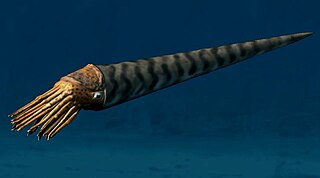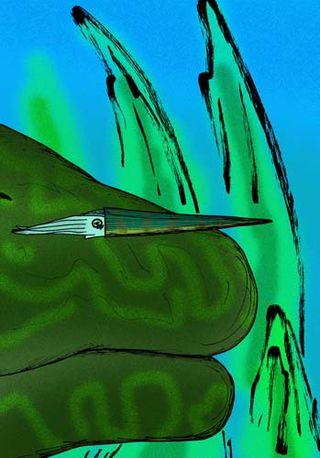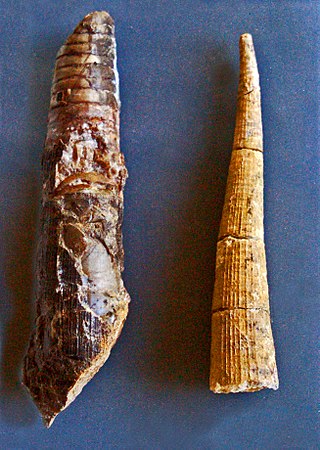
Orthoceras is a genus of extinct nautiloid cephalopod restricted to Middle Ordovician-aged marine limestones of the Baltic States and Sweden. This genus is sometimes called Orthoceratites. Note it is sometimes misspelled as Orthocera, Orthocerus or Orthoceros.

Orthoceratidae is an extinct family of actively mobile carnivorous cephalopods, subclass Nautiloidea, that lived in what would be North America, Europe, Asia, Africa, and Australia from the Ordovician through Triassic from 490—203.7 mya, existing for approximately 286.4 million years.

Orthocerida, also known as the Michelinocerida, is an order of extinct orthoceratoid cephalopods that lived from the Early Ordovician possibly to the Late Triassic. A fossil found in the Caucasus suggests they may even have survived until the Early Cretaceous, and the Eocene fossil Antarcticeras is sometimes considered a descendant of the orthocerids although this is disputed. They were most common however from the Ordovician to the Devonian.

The Bactritida are a small order of more or less straight-shelled (orthoconic) cephalopods that first appeared during the Emsian stage of the Devonian period with questionable origins in the Pragian stage before 409 million years ago, and persisted until the Carnian pluvial event in the upper middle Carnian stage of the Triassic period. They are considered ancestors of the ammonoids, as well as of the coleoids.

Lamellorthoceratidae is a family of fossil orthoceratoids in the Orthocerida, defined by Curt Teichert in 1961. The lamellorthoceratids are placed in the superfamily Orthocerataceae in the Treatise on Invertebrate Paleontology.
Spyroceras is a genus of pseudorthocerids from the Devonian of North America and Europe, defined by Alpheus Hyatt in 1884. Pseudorthocerids are a kind of orthocertaoid, a taxonomic group within the Nautiloidea. Specifically Spyroceras belongs to the pseudorthocerid family, Spyroceratidae.

Kionoceras is an extinct nautiloid cephalopod genus included in the orthocerid family Kionoceratidae with scattered worldwide distribution from the Middle Ordovician to the Lower Permian. Kionoceratids are orthocerids with prominent longitudinal ornamentation on their shells, sometimes augmented by secondary transverse ornamentation. Orthocerids are, of course, prehistoric nautiloides with generally straight and elongate shells, mostly with central or subcentral siphuncles.

Geisonoceratidae is an extinct family of orthoceroid cephalopods endemic to what would be Asia, Europe, and North America from the Middle Ordovician to the Middle Devonian living from about 470—380 mya, existing for approximately 90 million years. With the possible addition of an Early Cretaceous orthocerid from the western Caucasus the range of this group increases dramatically to some 350 million years, thus making it one of the longest lived families of the Nautiloidea.

Proteoceratidae is an extinct family of actively mobile aquatic carnivorous cephalopods belonging to the subclass Orthoceratoidea endemic to what would be Asia, Australia, Europe, South America and North America during the Ordovician living from 490—445.6 Ma, existing for approximately 44.4 million years.

Paraphragmitidae is an extinct family of actively mobile aquatic carnivorous cephalopods belonging to the subclass Orthoceratoidea endemic to what would be Asia and Europe during the Silurian living from 436 to 418.7 mya, existing for approximately 17.3 million years.
Pseudorthoceratidae is an extinct family of actively mobile aquatic carnivorous cephalopods belonging to the subclass Orthoceratoidea endemic to what would be North America, Asia, and Europe during the Silurian living from 460.5—251 Ma, existing for approximately 209.5 million years.

Dawsonoceratidae is an extinct family of orthoconic nautiloid cephalopods that lived in what would be North America and Europe from the Late Ordovician through the Middle Devonian from about 480–390 mya, existing for approximately 90 million years.
Garryoceras is an extinct genus, probably from the actively mobile carnivorous cephalopod order Orthocerida, that lived in what would be North America during the Late Ordovician, from 460.5—443.7 mya, existing for approximately 16.8 million years.

Narthecoceratidae is an extinct family of orthocone cephalopods who lived in marine environments in what is now North America during the Ordovician from 460.5—449 mya, existing for approximately 11.5 million years.
Tretoceras is an extinct genus of cephalopods included in the Orthocerida that lived in what would be Europe during the early Middle Ordovician, fossils of which have been found only in Austria.

Orthoceratoidea is a major subclass of nautiloid cephalopods. Members of this subclass usually have orthoconic (straight) to slightly cyrtoconic (curved) shells, and central to subcentral siphuncles which may bear internal deposits. Orthoceratoids are also characterized by dorsomyarian muscle scars, extensive cameral deposits, and calciosiphonate connecting rings with a porous and calcitic inner layer.

Kionoceratidae is a family in the Orthocerida, proposed by Hyatt in 1900 for genera characterized by prominent ornamentation in the form of longitudinal ribs, ridges, or lirae, or combinations thereof, sometimes with similar transverse ornament or faint transverse annulations.
Laumonttoceras is a genus in oncocerid family Jovellaniidae from the lower Devonian of Europe characterized by uncompressed, moderately expanding, orthocones with a central siphuncle composed of cylindrical segments that are slightly contracted at the septal openings and which contain discrete, discontinuous actinosphonate deposits.

Plagiostomoceras is an orthocerid cephalopod from the lower Paleozoic of Europe and Australia.
Glenesteroceras, which is of questionable validity, is based on a single specimen from the Lower Ordovician of New York state, described by Rousseau Flower, 1957.










